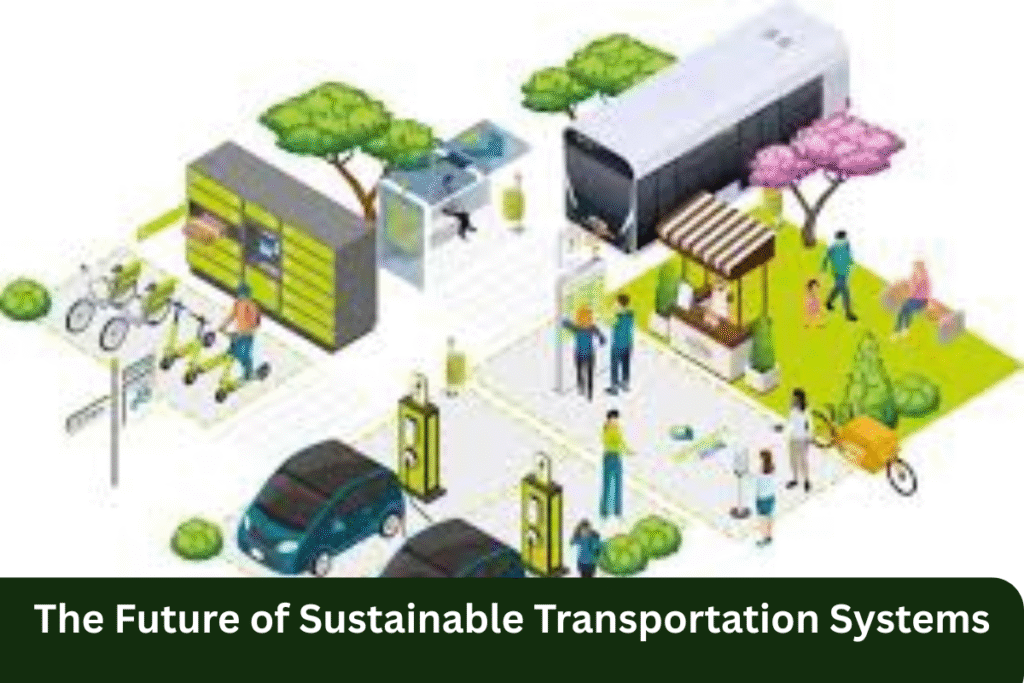
The global transportation sector is a major contributor to greenhouse gas emissions, air pollution, and resource consumption, making it a key area for climate change mitigation. As the world continues to grapple with environmental challenges, the need for sustainable transportation systems has never been more urgent. Sustainable transportation not only reduces the environmental impact of travel but also enhances efficiency, improves public health, and contributes to economic growth. In this article, we’ll explore the future of sustainable transportation systems, highlighting the innovative solutions, trends, and technologies that will shape the way we move in the years to come.
1. What is Sustainable Transportation?
Sustainable transportation refers to systems that use renewable energy sources, minimize environmental impact, and promote efficiency. It encompasses a range of transport modes, including public transit, electric vehicles (EVs), cycling, walking, and high-speed rail, designed to reduce reliance on fossil fuels and minimize pollution.
The goal of sustainable transportation is to create systems that:
- Reduce greenhouse gas emissions and air pollutants.
- Promote energy efficiency and lower energy consumption.
- Improve mobility and provide affordable, accessible transportation options.
- Enhance public health by reducing noise and air pollution.
By shifting towards more sustainable transportation, cities and countries can contribute to a low-carbon future, create healthier urban environments, and reduce the negative environmental effects of traditional transportation systems.
2. Key Trends Shaping the Future of Sustainable Transportation
The future of sustainable transportation will be driven by a combination of technological innovations, policy changes, and shifts in consumer behavior. Here are the key trends that will define the future of transportation systems:
a. Electrification of Transportation
The shift from fossil fuel-powered vehicles to electric vehicles (EVs) is one of the most significant trends in sustainable transportation. EVs produce zero tailpipe emissions, making them a crucial solution to reducing air pollution and carbon emissions.
- Electric Cars: The adoption of electric cars is rapidly increasing, with many governments offering incentives to encourage their use. Major automakers, including Tesla, Ford, and Volkswagen, are investing heavily in electric vehicle production, and more models are becoming available at various price points.
- Electric Buses and Trucks: Cities are adopting electric buses to reduce public transportation emissions, with many major cities, including London, Los Angeles, and Beijing, already operating fleets of electric buses. Additionally, electric trucks for freight transport are emerging as viable solutions to decarbonize the logistics industry.
- Electric Bikes and Scooters: Micro-mobility solutions, like electric bikes and scooters, are becoming increasingly popular for short-distance travel, providing an efficient and eco-friendly way to navigate urban environments.
b. Renewable Energy Integration
For transportation to truly become sustainable, the energy sources powering vehicles must be clean and renewable. The integration of renewable energy into the transportation sector is essential to reduce emissions from electricity generation.
- Solar Charging Stations: Solar-powered charging stations for electric vehicles are a growing trend. These stations allow EVs to be charged using clean, renewable energy, further reducing the carbon footprint of electric transportation.
- Wind and Hydro-Powered Transport: In regions where wind and hydroelectric power are abundant, transportation systems can be powered by these renewable sources, reducing reliance on fossil fuels and contributing to a low-carbon transportation future.
c. Public Transit and Shared Mobility
The future of sustainable transportation will rely heavily on efficient, low-emission public transportation systems and shared mobility services.
- High-Speed Rail: High-speed trains are an environmentally friendly alternative to short-haul flights. Countries like Japan, France, and China have already developed successful high-speed rail networks, reducing travel times while lowering emissions.
- Mobility-as-a-Service (MaaS): MaaS platforms allow users to plan, book, and pay for multi-modal transportation services (e.g., buses, trains, bikes, and ride-sharing) through a single app. By integrating various transportation modes, MaaS can reduce car dependence and make urban transportation systems more efficient and accessible.
- Ride-Sharing and Carpooling: Companies like Uber, Lyft, and Didi are integrating electric vehicles into their fleets and promoting shared rides to reduce the number of vehicles on the road and lower emissions. Carpooling apps are also becoming popular, especially in urban areas where traffic congestion and pollution are significant concerns.
d. Smart Infrastructure and Autonomous Vehicles
Technological advancements in smart infrastructure and autonomous vehicles are also playing a key role in shaping the future of sustainable transportation.
- Smart Cities and Intelligent Transport Systems: Smart cities are using digital technology and real-time data to optimize traffic flow, reduce congestion, and improve transportation efficiency. These systems use sensors and AI to manage public transit, parking, and traffic lights to reduce emissions and improve the overall sustainability of transportation networks.
- Autonomous Vehicles (AVs): Self-driving cars have the potential to revolutionize transportation by improving efficiency, reducing accidents, and lowering emissions. AVs can also integrate with shared mobility platforms, reducing the number of vehicles on the road while increasing the efficiency of transportation systems.
e. Cycling and Walking Infrastructure
Active transportation modes, such as cycling and walking, are essential components of a sustainable transportation system. Investing in infrastructure that supports these modes of travel is crucial for reducing emissions and promoting healthier lifestyles.
- Bicycle Lanes: Cities around the world are investing in dedicated bike lanes and bike-sharing programs, making cycling a safer and more convenient mode of transport.
- Pedestrian-Friendly Urban Design: Urban areas are being redesigned to prioritize pedestrians, with more green spaces, wider sidewalks, and pedestrian zones, encouraging walking as a mode of transport.
3. The Environmental Impact of Sustainable Transportation
Sustainable transportation systems offer significant environmental benefits:
- Reduced Carbon Emissions: By transitioning from fossil fuels to electric vehicles and renewable energy, sustainable transportation helps reduce the overall carbon emissions in the transportation sector.
- Improved Air Quality: Electrification of public transportation, reduction of traffic congestion, and promotion of cycling and walking help improve air quality by reducing pollutants like nitrogen oxides (NOx) and particulate matter (PM).
- Energy Efficiency: Electric vehicles and public transit systems are generally more energy-efficient than traditional vehicles powered by internal combustion engines (ICE), leading to a reduction in overall energy consumption.
4. FAQs
1. What is sustainable transportation?
2. How do electric vehicles contribute to sustainable transportation?
3. What are the benefits of high-speed rail in sustainable transportation?
4. How does public transportation help reduce emissions?
5. What role does cycling and walking play in sustainable transportation?
5. Conclusion
The future of sustainable transportation systems holds great promise for reducing emissions, enhancing mobility, and creating more sustainable, livable cities. Through the adoption of electric vehicles, renewable energy integration, and smarter urban planning, transportation can become a driving force in the global effort to combat climate change. As technology continues to evolve and governments and businesses invest in sustainable solutions, the shift to greener, more efficient transportation systems will play a pivotal role in shaping a sustainable future for generations to come.
